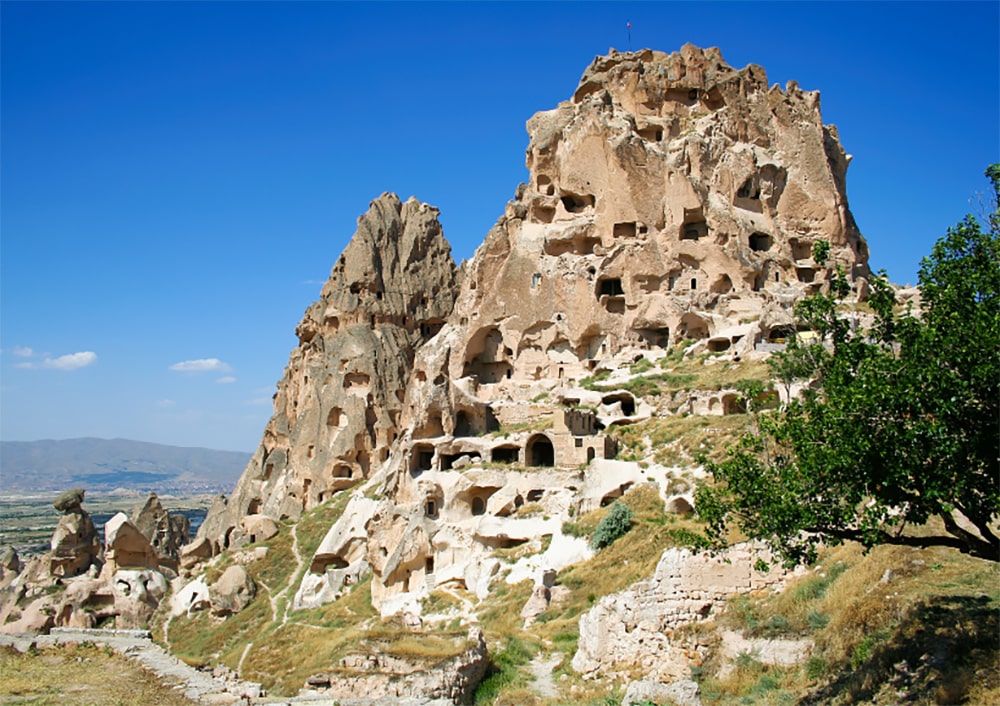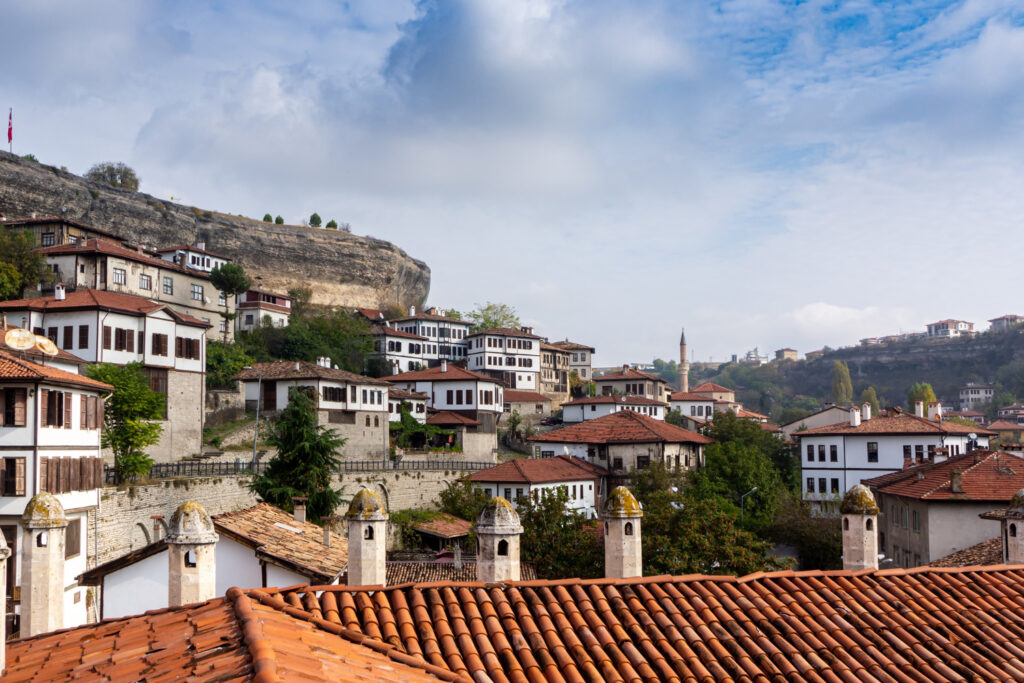Must-Visit Spots in Türkiye
1. Istanbul: Where East Meets West

No visit to Türkiye is complete without experiencing Istanbul — the city where continents meet, history breathes, and vibrant modernity thrives. Split between Europe and Asia by the shimmering Bosphorus Strait, Istanbul is a place where ancient traditions blend seamlessly with modern energy.
Highlights of Istanbul:
- Blue Mosque (Sultan Ahmed Mosque) – Renowned for its cascading domes and six minarets, the mosque’s interior is adorned with over 20,000 blue Iznik tiles, creating a serene and majestic atmosphere.
- Hagia Sophia – A true architectural marvel that has served as both a church and a mosque. Today, it stands as a powerful expression of Istanbul’s layered and multicultural history.
- Topkapi Palace – Once the opulent residence of Ottoman sultans, this palace complex features grand courtyards and the sacred relics chamber, which houses items linked to the Prophet Muhammad (PBUH).
- Bazaar Shopping – No trip to Istanbul is complete without getting lost in its legendary markets. The Grand Bazaar, one of the oldest and largest covered markets in the world, boasts over 4,000 shops selling everything from handwoven carpets and dazzling jewelry to leather goods and ceramics.
Just a short walk away, the Spice Bazaar (Egyptian Bazaar) offers a sensory overload of vibrant spices, exotic teas, Turkish delight, dried fruits, and fragrant herbs — a true feast for the senses.
Shopping Tips at the Grand Bazaar and Spice Market
- Practice the Art of Haggling
In the Grand Bazaar and Spice Market, prices are rarely fixed. Haggling is expected and part of the cultural experience. Start by offering 30–40% less than the asking price, and always stay polite and friendly.
- Use the “Walk Away” Technique
If you’re not getting the price you want, thank the seller politely and begin to walk away. More often than not, they’ll call you back with a better offer. If they don’t, it likely means you’ve reached their lowest price.Bonus tip: Buying in bulk? Ask for a package deal — many vendors offer generous discounts when you buy multiple items.
Know What to Look For
Popular and authentic items to shop for include:
- Turkish lamps and hand-painted ceramics
- Leather goods and handmade shoes
- Handwoven carpets and kilims
- Spices like sumac, saffron, and Turkish tea blends
- Natural soaps and skincare products made from olive oil and rosewater
Bring Cash
While some vendors accept cards, many prefer cash, especially in the Spice Market. Turkish Lira is your best bet for smooth transactions.
- Basilica Cistern – Descend into this atmospheric underground cistern, an ancient Byzantine water reservoir supported by 336 marble columns, including the hauntingly beautiful Medusa heads.
- Galata Tower – This iconic medieval tower offers sweeping 360-degree views of Istanbul, including the Golden Horn, the Bosphorus, and the Historic Peninsula.
- Explore Hidden Neighborhoods
- Balat and Fener: Once home to Greek Orthodox and Jewish communities, these adjacent UNESCO-listed neighborhoods are full of charm. Wander narrow cobblestone streets lined with brightly painted Ottoman-era houses, antique shops, and cozy cafés.
- Üsküdar (Asian side): A historic district known for its centuries-old mosques, traditional markets, and local life.
- Kadıköy and Moda (Asian Side): A lively, youthful area buzzing with creativity. Discover buzzing food streets, indie bookstores, street art, and a laid-back, artsy vibe along the waterfront.
2. Cappadocia: Land of Fairy Chimneys and Hot Air Balloons

If there’s one place in Türkiye that looks like it came straight out of a fantasy novel, it’s Cappadocia. Famed for its surreal landscape of fairy chimneys—towering, cone-shaped rock formations carved over millennia—this Central Anatolian wonderland offers a travel experience like no other.
Highlights of Cappadocia:
- Fairy Chimneys (Peribacaları): These whimsical rock formations, shaped by volcanic eruptions and erosion, dominate the landscape. Ranging from slender spires to mushroom-like caps, they create a backdrop that feels almost otherworldly.
- Hot Air Balloon Rides: The ultimate bucket-list experience. At dawn, Cappadocia becomes a sea of colorful balloons drifting silently over valleys and fairy chimneys.
Tips for Booking a Hot Air Balloon
Cost
Prices vary significantly based on season, flight duration, and basket size.
- Peak Season (April – June and September – October): €200 – €350+ per person for a standard 60-minute flight. Demand is extremely high.
- Low Season (November – March): €100–€250 per person, but be flexible — cancellations are common due to wind or snow.
- Deluxe or Private Flights: Expect higher prices for 90+ minutes or smaller, intimate baskets.
Best Time of Day
Sunrise is the ideal time to fly. Almost all reputable companies launch just before dawn, giving you a breathtaking view of the valleys bathed in golden light while hundreds of balloons drift across the sky.
Reputable Operators
Safety is paramount. Only book with companies licensed by the Turkish Civil Aviation Authority (DGCA). Highly rated operators include:
- Voyager Balloons
- Butterfly Balloons
- Royal Balloon
Booking in Advance
For high season (April–October), book months in advance to secure your spot. In the low season, a few weeks ahead is usually enough, but it’s still smart to reserve early. Last-minute bookings are risky.
- Ancient Cave Churches and Dwellings: Scattered throughout the valleys are thousands of rock-cut churches, monasteries, and homes. Many are decorated with remarkably preserved Byzantine frescoes.
- Unique Cave Hotels and Restaurants: Complete the experience by staying in a cave hotel, carved right into the stone. Many offer stunning views, traditional hospitality, and cave-style restaurants where you can savor local Anatolian cuisine.
Bonus tip: For Muslim travelers, halal food is widely available, and many hotels are sensitive to privacy and modesty needs, offering options like private terraces and family-friendly rooms.
Underground Cities:

- Derinkuyu Underground City: The deepest and largest excavated underground city in Türkiye, descending an astonishing 85 meters (280 feet) over eight levels and could house up to 20,000 people.
It features ommunal spaces, a missionary school, churches, and a complex ventilation system. - Kaymaklı Underground City: Known for its wider corridors and horizontal layout, Kaymaklı is easier to navigate than Derinkuyu—ideal for those uneasy in tight spaces. It also housed thousands of people and included living quarters, storage rooms, and wineries. A 9 km tunnel is believed to connect Kaymaklı and Derinkuyu!
Bonus Tip: Both sites are easily accessible via local bus or guided tours from Göreme or Nevşehir.
Hiking Trails:
- Rose Valley (Güllüdere Vadisi) and Red Valley (Kızılçukur Vadisi): These two interconnected valleys are named for the stunning hues of pink and red that color their rock formations, especially at sunset. Trails wind through orchards, vineyards, and past ancient cave churches carved into the cliffs.
- Love Valley (Aşıklar Vadisi): Known for its tall, phallic-shaped “fairy chimneys,” this valley offers an easy and enjoyable walk. It’s popular for its unique formations and panoramic viewpoints.
- Ihlara Valley: A lush, green canyon with a river running through it, located further from the main towns. This more challenging trail features dozens of hidden rock-cut churches and is ideal for a longer, immersive hike.
3. Ephesus: A Glimpse into Ancient Roman Life

Step back thousands of years and walk straight into a living chapter of ancient history as you stroll the marble streets of Ephesus. Once a bustling Roman metropolis and one of the largest cities of the ancient world, this UNESCO World Heritage Site is now one of Türkiye’s most spectacular and best-preserved archaeological sites.
Highlights of Ephesus:
- Library of Celsus: The iconic two-story grand façade was built in honor of Senator Tiberius Julius Celsus Polemaeanus. It once housed nearly 12,000 scrolls, making it one of the largest libraries in the ancient world.
- Great Theatre: An immense amphitheater with a seating capacity of 25,000, this theatre was not only used for dramatic performances but also for gladiatorial contests and political gatherings.
- Temple of Artemis (Artemision): While only a single column remains today, this site was once home to one of the Seven Wonders of the Ancient World. Dedicated to the Greek goddess Artemis, the temple was colossal and served as a significant religious and economic center.
- Hadrian’s Temple: A beautifully decorated Roman temple dedicated to Emperor Hadrian, featuring intricate carvings and a prominent archway.
When to Visit:
Ephesus can get extremely hot and crowded during midday, especially in summer. The best time to visit is early in the morning (around 8–9 AM), both to enjoy cooler temperatures and to experience the site before the tour groups arrive.
Late afternoon is also a good option, particularly in spring and autumn, when the lighting is perfect for photography.
Ticketing and Combo Options:
Entry to Ephesus is ticketed, and the main site ticket includes access to the Library of Celsus, the Great Theatre, and other ruins. However, there are also several nearby attractions that can be visited as part of a combined ticket or day trip, offering excellent value:
- Terrace Houses – These well-preserved Roman homes provide a rare look at elite urban life, complete with intricate mosaics and frescoes. Requires a separate ticket, but it’s worth the extra cost.
- Ephesus Archaeological Museum – Showcases many of the artifacts discovered at the site, including statues, coins, and everyday items from Roman life.
- House of the Virgin Mary – Located a short drive up Mount Koressos, this sacred site is believed by many to be where Mary, the mother of Jesus, spent her final years.
4. Antalya: Beaches, History, and Natural Beauty

Nestled on Türkiye’s stunning southwestern coast, Antalya is a sun-soaked paradise where golden beaches, turquoise waters, ancient ruins, and cascading waterfalls come together in perfect harmony.
Known as the gateway to the Turkish Riviera and often hailed as the “Pearl of the Mediterranean,” this vibrant city offers something for every traveler.
Highlights of Antalya:
- Kaleici (Old Town) – Step into a bygone era in Antalya’s atmospheric old town. Its narrow cobblestone streets are lined with beautifully restored Ottoman-era houses, boutique hotels, charming cafés, and small shops.
- Konyaaltı Beach – This long, pebbled stretch is a favorite among both locals and tourists thanks to its easy accessibility, stunning views of the Taurus Mountains, and excellent facilities.
- Lara Beach – Known for its soft, sandy shoreline and clear, shallow waters, Lara is home to the famous “Hotel Zone,” where many luxurious, all-inclusive resorts are built in extravagant themes resembling world landmarks.
- Düden Waterfalls: There are two main sections: the Upper Düden Waterfall, located inland within a lush park, where you can even walk behind the falls; and the dramatic Lower Düden Waterfall, which dramatically plunges off a cliff into the Mediterranean — best viewed by boat tour for the full effect.
- Perge: A sprawling archaeological site that features a grand Roman theatre, stadium, agora, bathhouses, and colonnaded streets.
- Aspendos: Home to arguably the best-preserved ancient Roman theatre in the world. Its acoustics are so perfect that it still hosts opera and ballet performances today.
Thrills and Family Fun:
- Antalya Aquarium – One of the largest in Europe, featuring an impressive underwater tunnel and interactive marine life zones.
- Jeep safaris and off-road tours – Great for teens and adults who love the outdoors.
- White-water rafting – A fun group activity that’s safe and supervised, ideal for adventurous families.
- Tünektepe Cable Car – Ride to the top for panoramic views of the city and coast.
- Pirate Boat Cruises – These themed tours include swimming stops, music, and even foam parties; many offer private or family-only options, and lunch on board is often halal.
5. Bodrum: The Aegean’s Chic Riviera

Often referred to as the St. Tropez of Türkiye, Bodrum is a dazzling coastal town on the Aegean Sea where rich history, vibrant nightlife, and natural beauty come together in perfect balance.
Once an ancient city of Halicarnassus — home to one of the Seven Wonders of the Ancient World — Bodrum is now a stylish resort destination that effortlessly blends ancient ruins with trendy boutiques, gourmet restaurants, and a bustling marina.
Highlights of Bodrum:
- Bitez Beach: A crescent-shaped bay known for its long, shallow sandy shores, calm waters ideal for families, and a hub for water sports like windsurfing.
- Camel Beach (Deve Beach): A popular, lively beach in Kargı Bay, famous for its sandy texture, clear waters, and the unique experience of camel rides along the shore.
- Bodrum Castle (Castle of St. Peter): Dominating the harbor, this magnificent medieval fortress was built by the Knights Hospitaller of St. John in the early 15th century.
- Museum of Underwater Archaeology: Housed within the Bodrum Castle, this award-winning museum is one of the world’s most significant museums dedicated to underwater archaeology.
Museum Highlights Include:
- The Uluburun Shipwreck Exhibit: This Bronze Age shipwreck, discovered off the coast of Kaş, is one of the oldest ever found.
- Glass Wreck Hall: Features a shipwreck filled with ancient glassware from the 11th century, beautifully displayed in glowing cases.
- Amphora Gallery: Houses hundreds of ancient clay amphorae used for storing wine, olive oil, and grains, many recovered from sunken ships.
- Carian Princess Hall: Showcases the opulent tomb of Ada of Caria, a local Persian-influenced queen, with her reconstructed burial chamber and fine jewelry.
6. Gaziantep: Culinary Capital of the Southeast

Welcome to Gaziantep, the crown jewel of southeastern Türkiye and a UNESCO Creative City of Gastronomy.
Gaziantep is a treasure trove for food lovers and culture seekers, where deep Islamic roots, centuries-old hospitality, and a rich Ottoman-era culinary legacy blend Anatolian, Arab, and Persian flavors into bold, spicy, and deeply satisfying dishes.
Must-Try Dishes:
- Baklava (Fıstıklı Baklava) – Gaziantep is world-famous for its pistachio-based baklava.
- Katmer – A flaky pastry filled with clotted cream and crushed pistachios, usually enjoyed at breakfast.
- Ali Nazik Kebab – A delicious combination of smoked eggplant puree topped with juicy marinated lamb and a dollop of yogurt.
- Beyran Çorbası – A spicy lamb and rice soup traditionally eaten for breakfast.
- Küşleme – A tender cut of lamb grilled to perfection, simple yet unforgettable.
Markets and Unique Food Experiences:
- Elmacı Pazarı – A bustling, authentic market where you can find a vast array of spices, dried fruits, nuts, traditional sweets, and local produce.
- Coppersmith Bazaar (Bakırcılar Çarşısı) – While primarily known for its copperware, this historic bazaar also offers a glimpse into traditional artisan work and is surrounded by local eateries.
- Imam Çağdaş Kebap ve Baklava Salonu – One of Gaziantep’s most famous and historic establishments (founded 1887), renowned for both its exceptional kebabs and its exquisite baklava.
Bonus tip: Almost all eateries in Gaziantep are halal-certified, and many are family-run, modestly styled, and cater well to Muslim travelers.
Museums to Visit:
- Zeugma Mosaic Museum – A highlight of the city and the largest mosaic museum in the world. It houses intricate Roman mosaics excavated from the ancient city of Zeugma, some of which date back over 2,000 years.
- Gaziantep City Museum – Offers insights into the region’s Ottoman and Islamic past, including traditional dress, tools, and daily life.
- Emine Göğüş Culinary Museum – A unique spot dedicated to preserving Gaziantep’s gastronomic traditions, with exhibits on historical kitchen tools, recipe books, and spices used over the centuries.
Bonus tip: Gaziantep is easily accessible via domestic flights or high-speed train from major cities like Istanbul and Ankara, and it’s well-suited for 2-3 day culinary extensions in your Türkiye itinerary.
7. Mount Nemrut: Colossal Statues and Stunning Views

Perched 2,134 meters high in southeastern Türkiye, Mount Nemrut is one of the country’s most awe-inspiring archaeological sites. Scattered across its summit are colossal stone heads—remnants of a 1st-century BCE tomb-sanctuary built by King Antiochus I of Commagene.
A UNESCO World Heritage Site, it’s especially stunning at sunrise or sunset, when golden light casts eerie shadows across the ancient faces..
How to Get There: Transportation & Tours
- By Air: The nearest airport is Adıyaman Airport (ADF), which receives domestic flights from Istanbul and Ankara. From the airport, it’s roughly a 2-hour drive to Mount Nemrut.
- By Car: For independent travelers, renting a car from nearby cities like Gaziantep or Şanlıurfa is an option, though the mountain roads can be winding and steep, especially near the summit.
- By Tour: The most convenient and popular option is joining a guided day tour or overnight tour from Adıyaman, Kahta, or even Cappadocia. Many tour operators include transport, meals, a professional guide, and entrance fees.
Bonus tip: Guided tours can accommodate prayer breaks and halal meals—inquire when booking with trusted providers.
What to Wear and Pack
- Layers: Mornings and evenings are chilly year-round. Bring a light down jacket or fleece even in July or August.
- Wind protection: A windbreaker or scarf is helpful, especially at sunrise when gusts can be strong.
- Comfortable shoes: The last 20–30 minutes involves a moderate hike on uneven gravel paths, so wear sturdy shoes or hiking boots.
- Flashlight/headlamp: Essential for sunrise tours, as you’ll hike in the dark.
- Snacks & water: While some tours include breakfast, it’s wise to bring your own water and light refreshments.
8. Safranbolu: An Ottoman Gem

Tucked away in the Black Sea region of northern Türkiye, Safranbolu is a perfectly preserved Ottoman-era town that feels like stepping into a time capsule.
Recognized as a UNESCO World Heritage Site, Safranbolu is celebrated for its elegant architecture, cobblestone streets, and slow, serene rhythm, making it a peaceful and culturally rich retreat for travelers.
Highlight of Safranbolu:
- Elegant Ottoman Atmosphere – Wander through narrow, winding cobblestone streets lined with meticulously preserved 18th- and 19th-century Ottoman houses.
- Historic Wood-Framed Mansions: Safranbolu’s iconic three-story homes feature high ceilings, carved wooden interiors, inner courtyards, and traditional architecture that reflect the lifestyle of wealthy merchant families.
Can you stay in them?
Absolutely. Many of these historic mansions have been lovingly restored and converted into boutique hotels or guesthouses, allowing travelers to experience authentic Ottoman living with modern comforts.
Popular options include:
- Gülevi Safranbolu
- İmren Lokum Konak
- Cinci Han Hotel
Several mansions have also been preserved as museums, such as:
- Kaymakamlar Evi (Governor’s House Museum): A restored mansion showcasing Ottoman domestic life, furniture, and household tools
- Hammam Museum: Located inside the historic Cinci Bathhouse, offering insights into Ottoman bathing rituals.
- Historic Market Areas – Strolling through Safranbolu’s bazaars is a cultural delight. Look for:
- Cinci Han Caravanserai: A well-preserved 17th-century inn that once hosted traders and merchants.
- Arasta Bazaar (Yemeniciler Arastası): A traditional cobblers’ market still practicing centuries-old crafts.
- Coppersmith Bazaar (Bakırcılar Çarşısı): Witness artisans handcraft copperware using techniques passed down for generations.
- Yenice Forest (Yenice Ormanları) – A short trip from Safranbolu takes you to one of Türkiye’s most pristine natural treasures. Recognized as one of Europe’s 100 biodiversity hot spots, Yenice Forest is ideal for nature lovers, eco-travelers, and halal-conscious families.
What can you do?
- Hiking Trails: Well-marked paths through oak, beech, and chestnut forests. Popular routes include Sazak Canyon and Şeker Canyon, offering peaceful walks and scenic views.
- Cycling and Eco-Tours: Local guides offer cycling routes and eco-tours to explore waterfalls, wildlife habitats, and ancient trees over 500 years old.
- Picnics and Family Walks: Quiet picnic spots, observation decks, and light trails make this an excellent place for families seeking modest, nature-based outings.
- Photography: A dream for landscape photographers, especially during autumn’s vibrant color change.
Bonus tip: While facilities may be basic in remote areas, many picnic spots and trailheads have nearby mosques or prayer spaces. Locals are known for their hospitality, especially toward families and Muslim travelers.
Looking for more Muslim-friendly destinations? Discover our top 10 picks for halal-friendly, culturally rich, and worry-free travel experiences worldwide!
Planning Your Türkiye Vacation
Türkiye is a destination that’s easy to love—and surprisingly easy to navigate, especially when you’re equipped with a few practical tips. Whether you’re visiting bustling cities, coastal towns, or quiet mountain villages, a little preparation goes a long way.
1. Basic Turkish Phrases
While English is widely spoken in tourist areas, knowing a few Turkish phrases can go a long way in building rapport with locals:
| Turkish | English |
| Merhaba | Hello |
| Günaydın | Good evening |
| Teşekkür ederim | Thank you |
| Lütfen | Please |
| Evet / Hayır | Yes / No |
| Nerede? | Where is…? |
| Ne kadar? | How much? |
Bonus tip: Most Turks understand the concept of halal. Simply saying “helal mi?” when ordering food usually gets a helpful response.
2. Safety Guidelines
Türkiye is generally a safe country to visit, but it’s always wise to stay aware of your surroundings and exercise common sense while traveling.
- Keep valuables secure in crowded places like bazaars or public transport.
- Stick to registered taxis or use ride-sharing apps in bigger cities.
- Avoid border regions near Syria, as advised by most governments.
3. Local Etiquettes
While Türkiye is known for its warm hospitality, understanding local customs and etiquette can help you connect more respectfully with locals and avoid unintentionally causing offense.
- Dress modestly when visiting mosques or rural towns. Women should carry a scarf to cover their hair when entering religious sites.
- Remove your shoes before entering a mosque or someone’s home.
- Public displays of affection are discouraged, especially in conservative areas.
- Use your right hand when eating or offering something—it’s considered more polite.
4. Typical Budget Ranges for Different Travel Styles
Türkiye caters to all budgets, from backpackers to luxury seekers. Here’s a rough guide for daily spending:
- Budget Travel: RM 140 – RM 235/day ($30–50 USD)
(Public transport, dorm stays, street food, free activities) - Mid-Range Travel: RM 330 – RM 705/day ($70–150 USD)
(3-star hotels, halal restaurants, local tours, domestic flights) - Luxury Travel: RM 940+/day ($200+ USD)
(Boutique hotels, private tours, premium experiences, shopping)
5. Tipping
Tipping isn’t mandatory in Türkiye, but it’s widely appreciated and often expected in service-based industries. Here’s a quick tipping guide:
| Service | Suggested Tip |
| Restaurants | 5 – 10% of the bill or round up |
| Hotel staffs | ₺20 – ₺40 |
| Tour guides | ₺100 – ₺250 per day (depending on group size and quality) |
| Taxi drivers | Not required, but rounding up to the nearest lira is polite |
Bonus tip: Tipping is usually done in cash (Turkish Lira) and handed directly to the individual.
Ready to Explore Türkiye Like a Seasoned Traveler?
By uncovering Türkiye’s rich history, vibrant culture, and breathtaking landscapes, you’ll experience so much more than a holiday, you’ll walk in the footsteps of empires and immerse yourself in centuries of Islamic heritage.
Whether you’re cruising down the Bosphorus, exploring ancient ruins in Ephesus, or watching hot air balloons rise over Cappadocia, every moment promises meaning and wonder.
If you’re looking for a Muslim-friendly, worry-free journey, Dina Travel offers curated Türkiye packages and custom itineraries tailored to your values. From halal meals to prayer-friendly accommodations, we ensure every detail of your Türkiye trip is taken care of, so you can focus on enjoying the experience.
Frequently Asked Questions
Yes! Türkiye is easy to explore on your own, with good infrastructure and domestic flights. However, guided tours can help maximize your time, especially in regions like Cappadocia or southeastern Türkiye where transportation can be less frequent.
Beauty in Türkiye is wonderfully diverse. For surreal landscapes, Cappadocia takes the crown with its fairy chimneys and sunrise balloon rides. For coastal charm, head to Antalya or Bodrum—turquoise seas, dramatic cliffs, and ancient ruins. If history and skyline views are more your style, Istanbul delivers the full package.
Konya is often regarded as the most religious city in Türkiye. It’s home to the tomb of Jalaluddin Rumi, a major spiritual figure, and has a deeply conservative and spiritual atmosphere. It’s also known for the Whirling Dervishes, a Sufi tradition still practiced today.
Istanbul is ideal. It offers countless mosques, halal food options, Islamic heritage sites, and a wide range of modest accommodations. Other cities like Bursa, Konya, and Sanliurfa also provide rich Islamic history and a faith-friendly environment.
Malaysian passport holders do not need a visa for short stays (up to 90 days). Visitors from other countries should check the official Turkish e-Visa website to confirm visa requirements.

